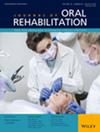Effect of Mandibular Advancement on Condylar Remodelling of Class II Malocclusion Adolescent Patients With or Without Anterior Disc Displacement: A Retrospective Study
Abstract
Objective
To compare condylar remodelling in Class II malocclusion adolescents with or without anterior disc displacement (ADD) before and after treatment with mandibular advancement.
Methods
CBCT data were collected from 20 Class II division 1 malocclusion adolescent patients with normal disc-condyle relationships and 20 Class II division 1 malocclusion adolescent patients with ADD, before and after mandibular advancement. All the TMJs were classified into three types: normal disc-condyle relationship joint, anterior disc displacement with reduction (ADDwR) joint, and anterior disc displacement without reduction (ADDwoR) joint. 3D Slicer 5.0.3 software was used to compare the quantitative index changes before and after treatment, including condylar volume, superficial area, morphological index, maximum cross-sectional area, width, depth, height and length. In addition, three-dimensional reconstructions and superimpositions of the condyle-glenoid fossa were performed to visualise condylar remodelling, and the condylar osseous change during treatment was evaluated qualitatively.
Results
Before treatment, the morphological index and depth of the condyle were smaller in the ADDwoR joint. After treatment, condylar dimensions increased in all three types. The amount of increase in various indices of the ADDwR joint was comparable to that of the normal joint, with the highest rate of condylar repair and regeneration observed in the ADDwR joint. Specifically, the condylar volume changes in the normal joint (95% CI: 187.59 ± 107.05) and the ADDwR joint (95% CI: 199.97 ± 135.32) showed no significant difference (p = 0.672). The increase in condylar volume (p < 0.05), superficial area (p < 0.01) and length (p < 0.01) in the ADDwoR joint was lower than that in the normal joint. Three-dimensional reconstructions showed posterior and superior condylar growth in all three types.
Conclusion
Mandibular advancement significantly promotes condylar remodelling in Class II malocclusion adolescent patients, with or without ADD, effectively promoting the backward growth of the condyle. Condylar growth of ADDwR joints was comparable to that of normal joints, while the condylar growth of ADDwoR joints was less.

 求助内容:
求助内容: 应助结果提醒方式:
应助结果提醒方式:


